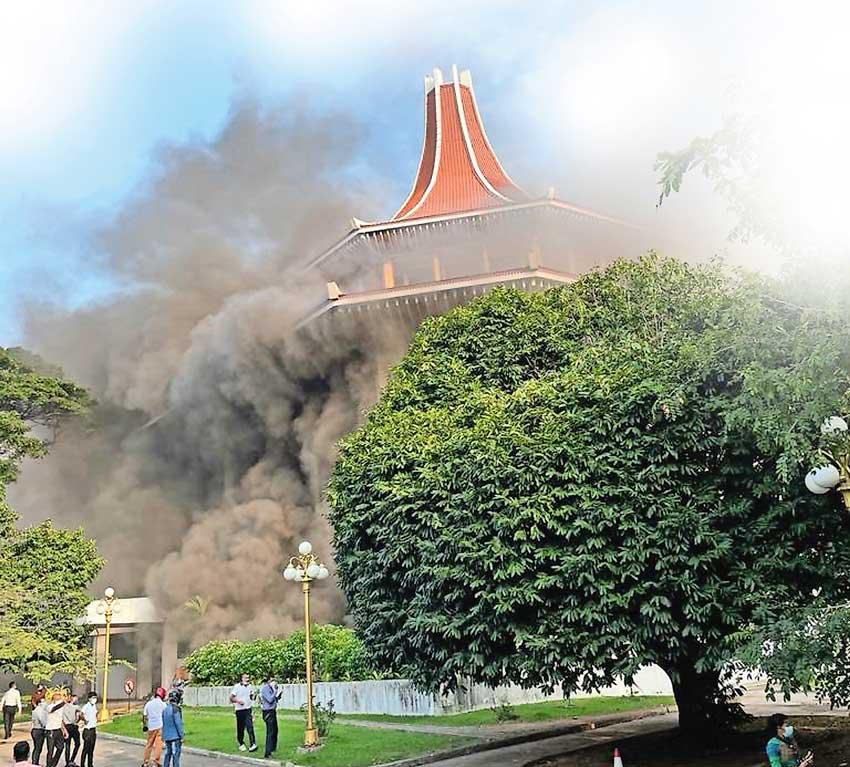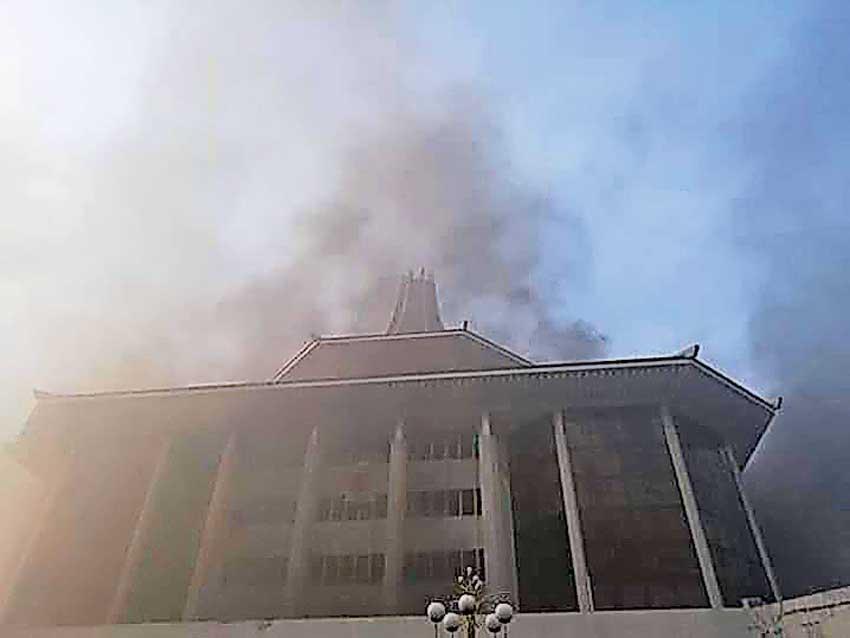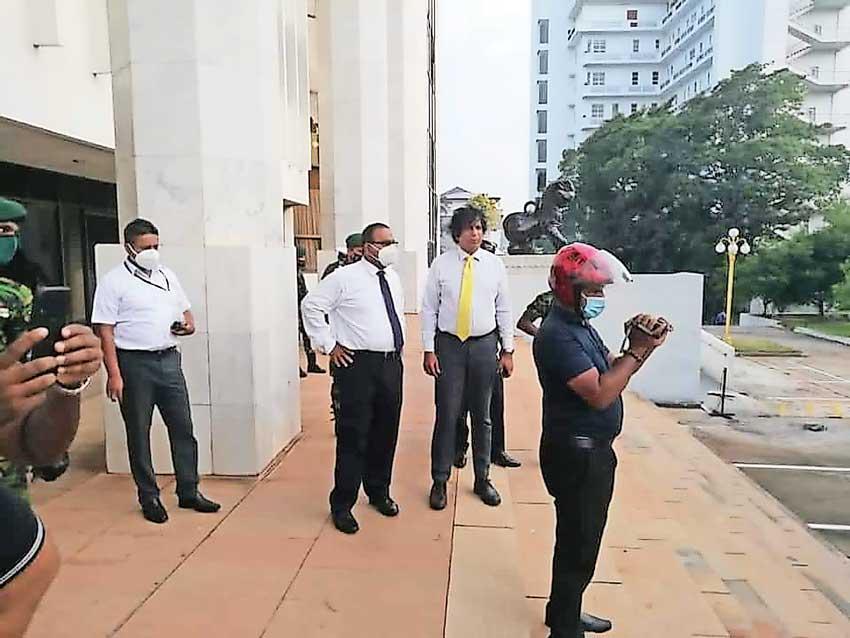17 Dec 2020 - {{hitsCtrl.values.hits}}
As the country grapples with the pandemic, a fire breaks out at the country’s Apex Court.
No documents, registries damaged, say Police.

 Massive plumes of grey smoke wafted from a fire which broke out at the Hulftsdorp Supreme Court complex in Colombo on Tuesday evening (December 15). The smoke which engulfed the country’s Apex Court caused public alarm with Police top brass as well as the Attorney General himself visiting the site immediately.
Massive plumes of grey smoke wafted from a fire which broke out at the Hulftsdorp Supreme Court complex in Colombo on Tuesday evening (December 15). The smoke which engulfed the country’s Apex Court caused public alarm with Police top brass as well as the Attorney General himself visiting the site immediately.
However, the fire believed to have originated in the ground floor of the building at around 4.45 pm was contained by firefighters within an hour. Issuing a statement, the Government assured the public that no court records had been damaged or destroyed in the fire at the Supreme Court complex. The press release issued by the Department of Government Information said that the fire erupted in an area where waste and other discarded material were stored.
Secretary to the Ministry of Justice M. M. P. K. Mayadunne in his letter said: “A fire has broken out in the waste material store in the Colombo Supreme Court premises at around 4.45 pm today, but it did not damage any office of the Supreme Court or any other item including files.”

Fire was contained in 40 minutes since it broke out
Poor combustible storage, lack of ventilation, storage of inflammable liquid could cause fire in buildings
The Supreme Court usually requests for a fire inspection once a year
Assistance could now be obtained from SLAF, SNL, CPC firefighting units
Fire is identified as the second highest disaster topology in Sri Lanka
Police Spokesperson DIG Ajith Rohana addressing the media last evening reiterated that no court documents or registry was damaged or destroyed in the incident. “The Criminal Investigations Department (CID) has launched an investigation into the fire, assisted by Police Scene of Crime Officers (SOCO) to collect scientific evidence,” he said.
Meanwhile, experts from the Government Analysts Department, who were consulted during the investigation, are due to submit their reports this evening, DIG Rohana said on Wednesday.
The fire believed to have originated in the ground floor of the building at around 4.45 pm was contained by firefighters within an hour
Sri Lanka’s Supreme Court complex was built in 1989 with the assistance of the Chinese Government. Over 25 years since the construction, the building was renovated in 2015 by a Chinese construction firm upon the request of the Sri Lankan government.
The roofing and the auditorium were subject to renovations in 2015, while the interior roofing, as well as the ceremonial hall too had been refurbished. A special attention was paid to the court complex’s fire extinguisher pipe system and its electric lifts during this renovation.

Attorney General Dappula de Livera is seen standing opposite the Supreme Court Complex
Fire hazards in State facilities
A team of 20 brave firefighters were able to douse the fire before it could cause any casualties, Colombo Municipal Council’s Chief Fire Officer P. D. K. A. Wilson told the Daily Mirror.
“I have dispatched another Fire Fighting team this morning as well to observe and investigate the incident. Preliminary investigations have revealed that the fire erupted in a storage facility. All discarded items have been stored in this area,” Wilson said.
“These items are counted as inventory goods and as a practice in most government institutions; you cannot dispose of them immediately. These items could only be disposed upon the approval of the head of that particular organisation,” Wilson explained. “In this instance, the fire would have originated in one of those rooms where the disposable items are stored. We were unable to see at first sight as to what was the cause of this. But fortunately, we were able to control the fire within an hour. According to initial observations made by the team, the fire originated from the ground floor or perhaps even from the basement,” he said.
Supreme Court complex was built in 1989 with Chinese Government assistance and was renovated in 2015 by a Chinese construction firm
As it was an essential service, the Chief Fire Officer deployed eight firefighting trucks along with the crew. Around 20 firefighters and three senior officers were dispatched to the site. Wilson said the fire had consumed a large volume of plastic material, which caused the huge thick plumes of black smoke billowed from the site. “Carbonic material when caught in a fire produces thick billows of smoke. This smoke spread through the building and wafted from the top. Everyone thought the damage the fire had caused was much greater.”
“Even it was the Supreme Court; our firefighters rushed right in, despite the smoke. But they managed to identify the location and extinguished the fire. Within 40 minutes we were able to bring the situation under control, but the smoke continued for hours, which is usually the case during incidents such as this.”
Asked if this kind of incident is likely to cause any structural damage to the building, Mr. Wilson said since the fire was contained within a matter of minutes, it was unlikely that the building’s structural integrity was compromised. “However, if it had continued for another two or three hours, the damage to the structure could have been extensive,” he said.
Common fire hazards such as overload, poorly-built or maintained electric control panels, flammable liquid storage and heat-generating objects could also lead to such situations.
Interestingly combustible storage areas with insufficient protection and ventilation are also classified as potential fire hazards. Many State and commercial buildings have a build-up of combustible materials, such as paper, cardboard and plastic.
Smoke spread through the building and wafted from the top. Everyone thought the damage the fire had caused was much greater
What kind of precautions are in place?
If the Supreme Court is vulnerable to this kind of incident, what could it mean for the country’s other State infrastructure, we asked the experienced fire fighting expert.
“I dispatched a team of officers in the morning today, since we had gone through fire prevention methods in this particular building in the past as well. Now we are in the process of identifying, if there were any other update or requirement. Our officers will come back with this information,” Wilson said.
Asked how regularly buildings are inspected for their fire safety precautions, Wilson said the Fire Department usually inspects upon request. “When it comes to important buildings such as the Supreme Court complex, the Pensions Department or the President’s House, we perform inspections annually. The Supreme Court usually requests for an inspection once a year,” he added.
In the event of fire which is difficult to control, the Fire Department relies on additional resources, Wilson said, stressing that the Fire Department has sufficient manpower to cater to an emergency in Colombo. “We have back up teams from the Sri Lanka Air Force. Now the Sri Lanka Navy too is equipped with fire fighting vehicles and that assistance could be obtained from them as well. We have the Petroleum Corporation Firefighting unit as well in Kotte and Dehiwala. So we can solicit their support when there is a major fire,” he said.
Similar incident in April
Interestingly, earlier this year in April, a fire broke out at the Department of Government Printing in Borella.
A similar team of 20 firefighters was dispatched to douse the fire along with four fire engines. The Government Printers said the fire broke out at a storage facility to store discarded paper.
Despite, many fire detection and protection techniques available today, fire in buildings are still considered a major threat to the occupants.
According to a literature review of the Department of Building Economics of the University of Moratuwa, the Asian region was identified as the second-highest region with non-compliance of fire safety. Meanwhile, fire is identified as the second highest disaster topology in Sri Lanka.
Perhaps it is time that the Government finds a solution to effectively managing waste material at state departments, eliminating fire hazards which could potentially destroy and destruct in a matter of minutes.
24 Nov 2024 2 hours ago
24 Nov 2024 2 hours ago
24 Nov 2024 4 hours ago
24 Nov 2024 8 hours ago
24 Nov 2024 9 hours ago